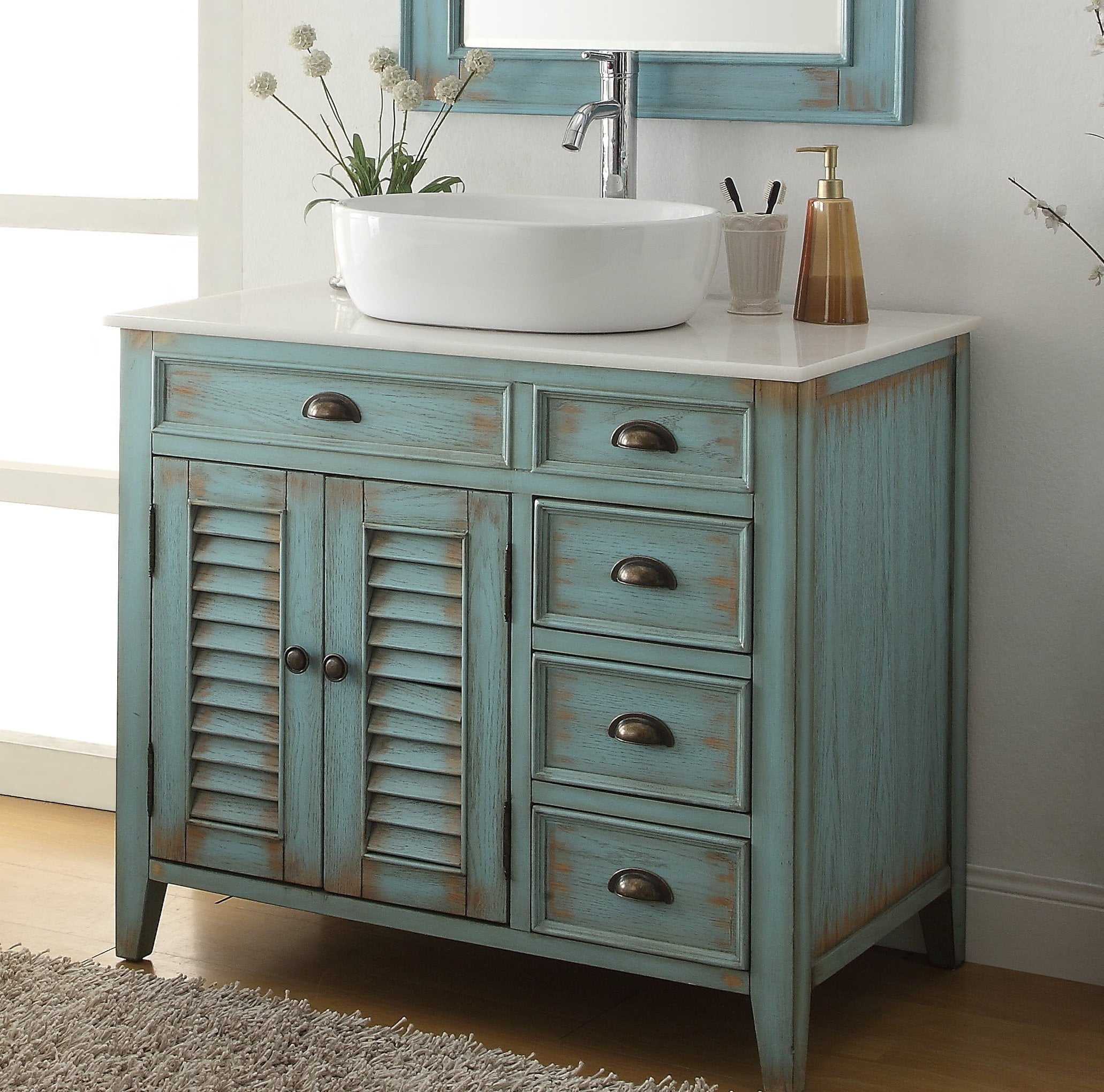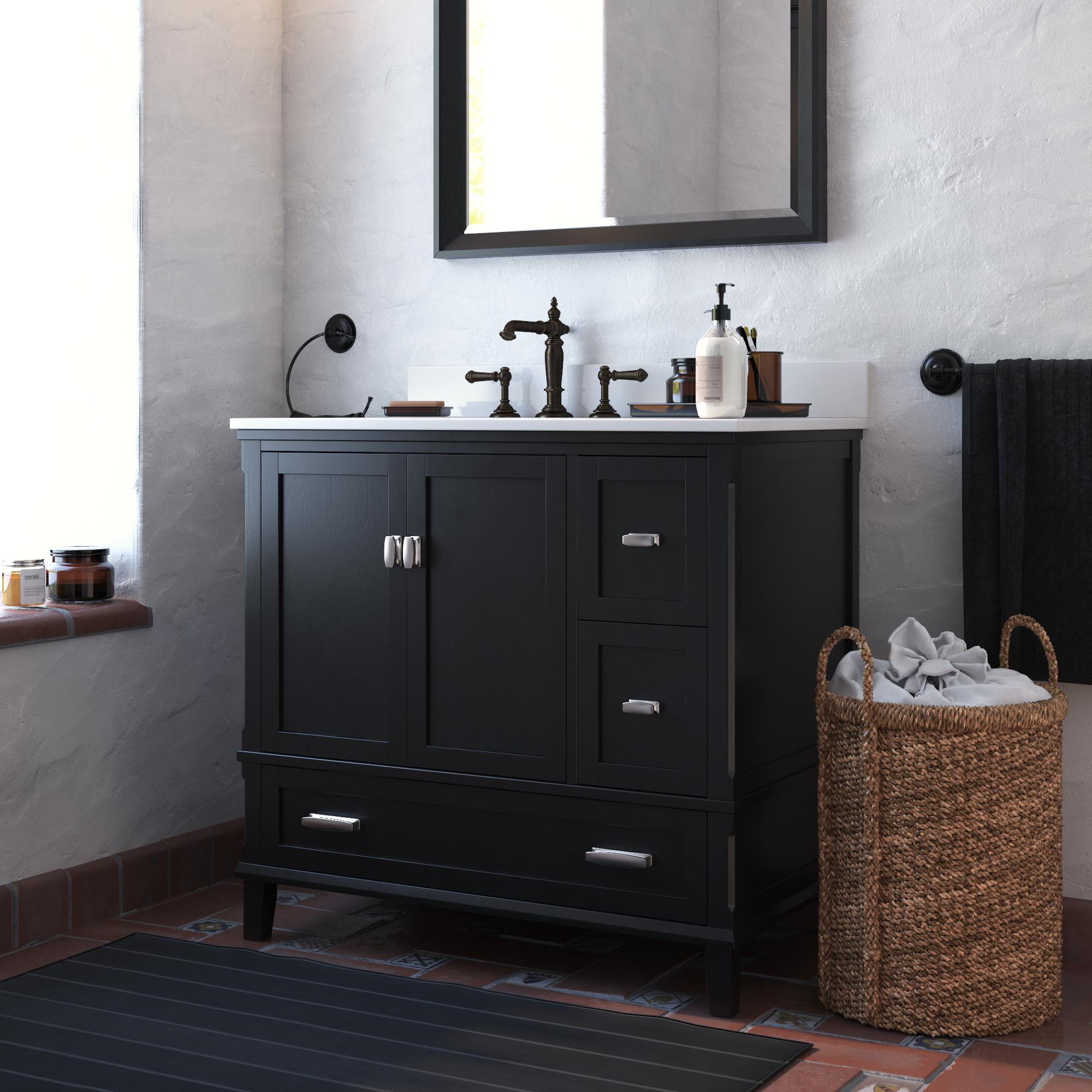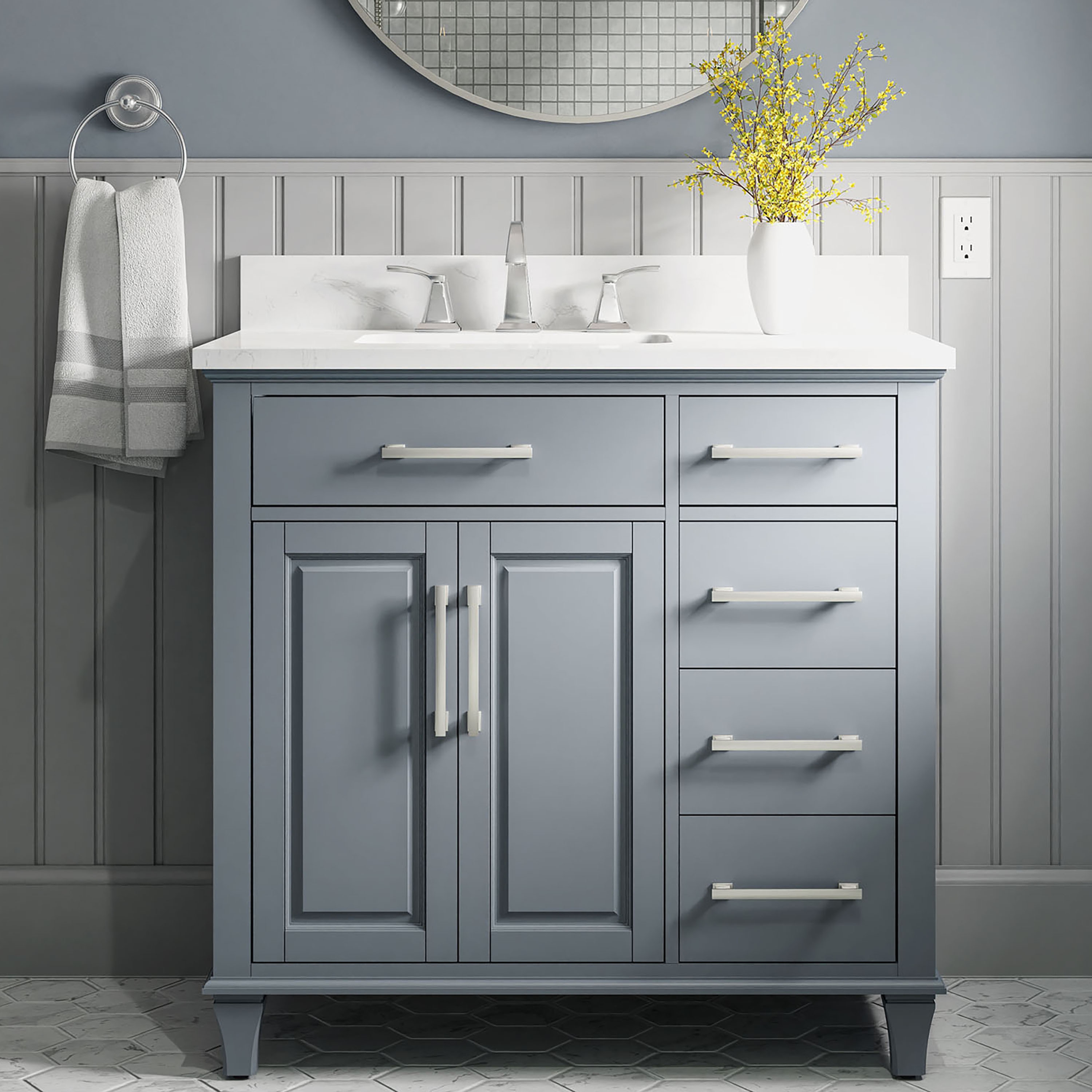Understanding Freestanding 36 Inch Bathroom Vanities

A freestanding 36-inch bathroom vanity is a stylish and practical choice for any bathroom, offering a unique blend of functionality and design. These vanities are independent units, typically featuring a countertop, sink, and storage cabinets, standing on their own without being attached to the wall.
Freestanding Vanity Features and Benefits, Freestanding 36 inch bathroom vanity
Freestanding vanities offer a range of benefits, making them a popular choice for homeowners seeking a functional and aesthetically pleasing bathroom solution.
- Enhanced Flexibility: The freestanding design allows for greater flexibility in bathroom layout, as they can be placed anywhere in the room without being limited by wall constraints. This is especially beneficial for smaller bathrooms where space is limited or for creating unique bathroom layouts.
- Increased Storage Space: Freestanding vanities often come with spacious cabinets and drawers, providing ample storage for toiletries, towels, and other bathroom essentials. This helps to keep the bathroom organized and clutter-free.
- Aesthetic Appeal: Freestanding vanities are available in a variety of styles and materials, allowing homeowners to choose a vanity that complements their bathroom décor. They can add a touch of elegance and sophistication to any bathroom, enhancing the overall aesthetic appeal.
- Easy Installation: Freestanding vanities are relatively easy to install, as they do not require any complex wall mounting procedures. This makes them a convenient option for homeowners who prefer a quick and straightforward installation process.
Comparison with Wall-Mounted Vanities
While freestanding vanities offer several advantages, it’s important to compare them with wall-mounted vanities to understand their unique features and benefits.
- Space Optimization: Wall-mounted vanities are a great choice for maximizing space, especially in smaller bathrooms. They create a sense of openness and can make the room feel larger. Freestanding vanities, on the other hand, require more floor space and can potentially make a smaller bathroom feel cramped.
- Accessibility: Wall-mounted vanities can be installed at a lower height, making them more accessible for individuals with mobility limitations. Freestanding vanities may be taller, which could pose a challenge for some users.
- Plumbing Considerations: Wall-mounted vanities often require concealed plumbing, which can be more challenging to install and repair. Freestanding vanities typically have visible plumbing, making them easier to access and maintain.
- Style and Design: Both freestanding and wall-mounted vanities come in various styles and materials, offering a wide range of design options to suit different preferences. The choice between the two ultimately depends on personal taste and the overall bathroom design.
Freestanding Vanity Styles and Materials
Freestanding vanities are available in a wide array of styles and materials, catering to different tastes and budgets.
- Traditional Styles: Traditional freestanding vanities often feature intricate carvings, ornate hardware, and classic designs. They are typically made from solid wood, such as oak or cherry, and can add a touch of elegance and sophistication to a bathroom.
- Modern Styles: Modern freestanding vanities are characterized by clean lines, minimalist designs, and sleek finishes. They are often made from materials like acrylic, laminate, or metal, creating a contemporary and sophisticated look.
- Transitional Styles: Transitional freestanding vanities blend elements of both traditional and modern styles, offering a harmonious balance between classic and contemporary design. They can feature a combination of wood, metal, and other materials, creating a versatile and stylish look.
- Materials: Freestanding vanities are available in a wide range of materials, including wood, acrylic, laminate, metal, and stone. The choice of material will affect the vanity’s durability, style, and price. For instance, solid wood vanities are typically more expensive but offer a classic and durable option. Acrylic vanities are more affordable and offer a sleek and modern look. Laminate vanities are a budget-friendly option that provides a wide range of colors and patterns.
Choosing the Right Freestanding Vanity

Selecting the perfect freestanding vanity for your bathroom is a crucial step in creating a functional and aesthetically pleasing space. It’s an investment that will impact your bathroom’s overall look and feel for years to come.
Bathroom Size and Layout
The first step in choosing a freestanding vanity is to assess your bathroom’s size and layout. This will help you determine the maximum dimensions of the vanity you can accommodate. Consider the following factors:
- Available Space: Measure the available space in your bathroom where you want to place the vanity. Ensure you have enough room to open doors and drawers without obstruction.
- Traffic Flow: Consider the flow of traffic in your bathroom. You don’t want the vanity to block the entrance or create a cramped feeling. Leave ample space for movement around the vanity.
- Existing Fixtures: Take note of the location of other fixtures in your bathroom, such as the toilet, shower, and bathtub. A well-placed vanity will complement these fixtures and create a balanced layout.
Bathroom Style
The style of your bathroom plays a significant role in choosing the right freestanding vanity. The vanity should complement the overall design aesthetic of your bathroom, whether it’s modern, traditional, contemporary, or rustic.
- Traditional Style: Consider vanities with intricate carvings, ornate hardware, and a classic design. These vanities often feature solid wood construction and a warm, inviting feel.
- Modern Style: Modern vanities prioritize clean lines, sleek surfaces, and minimalist designs. They often feature materials like metal, glass, and high-gloss finishes.
- Contemporary Style: Contemporary vanities blend modern elements with a touch of traditional design. They might feature geometric shapes, bold colors, and unique textures.
- Rustic Style: Rustic vanities evoke a sense of warmth and natural beauty. They often feature reclaimed wood, distressed finishes, and natural elements like stone or metal accents.
Countertop Materials
The countertop material for your freestanding vanity is a significant design element. It influences the overall look and feel of your bathroom, and it should be chosen based on durability, maintenance requirements, and style preferences.
- Granite: A popular choice for countertops, granite is known for its durability, scratch resistance, and unique patterns. It comes in a wide range of colors and finishes.
- Marble: Marble is a luxurious and elegant option that adds a touch of sophistication to any bathroom. However, it is more porous than granite and requires more maintenance.
- Quartz: Quartz is an engineered stone that offers durability, stain resistance, and a wide range of colors and patterns. It is a low-maintenance option that is popular for countertops.
- Solid Surface: Solid surface countertops are made from a non-porous material that is easy to clean and maintain. They are available in a wide range of colors and can be molded into various shapes.
Sink Types
The type of sink you choose for your freestanding vanity can significantly impact its functionality and aesthetics.
- Undermount Sink: Undermount sinks are installed beneath the countertop, creating a seamless and modern look. They are easy to clean and provide ample counter space.
- Vessel Sink: Vessel sinks sit on top of the countertop, adding a unique and stylish element to the bathroom. They come in various materials and designs.
- Drop-in Sink: Drop-in sinks are the most common type of sink. They are installed directly into the countertop, offering a classic and affordable option.
Storage Options
Storage options are essential for keeping your bathroom organized and clutter-free.
- Drawers: Drawers provide ample storage space for toiletries, towels, and other bathroom essentials. Look for drawers with soft-close mechanisms for a quiet and smooth operation.
- Cabinets: Cabinets offer more vertical storage space for larger items like towels, linens, and cleaning supplies. Consider cabinets with adjustable shelves for customized storage.
- Open Shelving: Open shelving provides easy access to frequently used items. It can also add a decorative element to the bathroom.
Installation and Maintenance: Freestanding 36 Inch Bathroom Vanity

Installing a freestanding bathroom vanity is a straightforward process, but it’s essential to follow the right steps to ensure proper functionality and longevity. This section will guide you through the installation process, provide tips for plumbing connections and leveling, and explain routine maintenance practices to maximize the lifespan of your freestanding vanity.
Installing a Freestanding Bathroom Vanity
Installing a freestanding bathroom vanity typically involves these steps:
- Prepare the Location: Choose a location that is level, stable, and allows for adequate clearance around the vanity for access and movement. Ensure the floor is clean and free of debris.
- Install Plumbing: Connect the vanity’s drain to the existing waste line, and the water supply lines to the hot and cold water sources. Make sure the connections are secure and free of leaks.
- Level the Vanity: Use a level to ensure the vanity is perfectly level in all directions. Adjust the vanity’s feet or shims to achieve proper leveling. This is crucial for the vanity’s stability and to prevent water from pooling on the countertop.
- Secure the Vanity: Once leveled, secure the vanity to the floor using the provided mounting hardware or by attaching it to a wall stud for added stability.
- Install the Sink and Faucet: Install the sink onto the countertop, ensuring it’s properly aligned and secure. Then, install the faucet, making sure it’s connected to the water supply lines and the drain.
- Connect the Mirror and Accessories: If applicable, install the mirror and any other accessories like towel bars or shelves.
Ensuring Proper Plumbing Connections and Leveling
Proper plumbing connections and leveling are crucial for the vanity’s functionality and longevity.
- Plumbing Connections: Ensure all plumbing connections are secure and leak-free. Use thread sealant tape on threaded connections to prevent leaks. Double-check all connections for any signs of leaks after the installation is complete.
- Leveling: Leveling the vanity is essential for stability and to prevent water from pooling on the countertop. Use a level to ensure the vanity is perfectly level in all directions. Adjust the vanity’s feet or shims to achieve proper leveling.
Routine Maintenance Practices
Regular maintenance is key to extending the lifespan of your freestanding bathroom vanity.
- Clean Regularly: Clean the vanity countertop, sink, and surrounding areas regularly with a mild cleaner. Avoid harsh chemicals that can damage the finish.
- Inspect for Leaks: Regularly check for leaks around the plumbing connections and the sink. Address any leaks promptly to prevent water damage.
- Maintain the Faucet: Clean the faucet regularly to prevent mineral buildup. Lubricate moving parts as needed.
- Inspect the Drain: Ensure the drain is clear of obstructions and functioning properly. Clean the drain regularly to prevent clogs.
- Check the Hardware: Regularly inspect the vanity’s hardware, including the doors, drawers, and hinges. Tighten any loose screws or replace worn-out hardware as needed.
